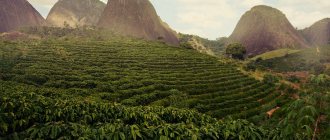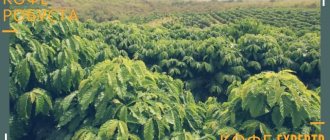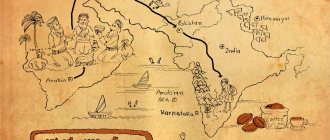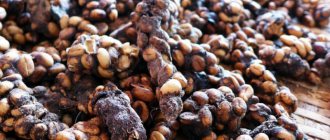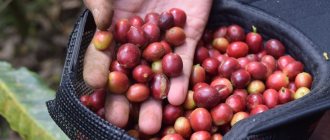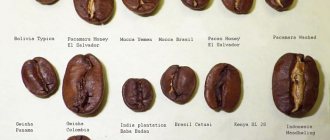History with geography
The coffee industry is one of the main sectors in the country's economy, so it is not surprising that the majority of the country's population works here. Among the world's exporters, Guatemala is definitely in the TOP 10. Who made seemingly ordinary coffee beans so famous?
Coffee seedlings appeared in Guatemala thanks to Jesuit monks. It was they who, together with the word of God, brought coffee grains to Central America to the aborigines in the 18th century. But the country's climate is completely unsuitable for high yields. Therefore, for almost a century, the plantations of this plant were quite modest. The scorching sun did not give the fragile trees a chance.
But in the 19th century, the country's leadership relied on the coffee industry. It was as a result of this that European settlers received large plots of land in the country. And the decision did not take long to arrive.
For new plants, they found a place in the shade of trees and thus protected the sprouts from heat and direct sunlight. As a result, coffee plantings spread and occupied large areas of Guatemala.
Today, more than 800 million coffee trees grow here. It should be noted that the country takes a responsible approach to the coffee industry, which means strict quality control of products at all stages of production and the export process.
Why did Arabica take root?
Initially, little attention was paid to coffee production. But as soon as the residents themselves appreciated the taste of the roasted grains, their aroma and properties, it was decided to develop mountain plantations. This is how new varieties appeared in the coffee industry, and the first batches of exported Guatemala coffee beans were sent to Europe and America.
It was for the Arabica variety that the heights became comfortable territory for rich harvests. Therefore, intolerant leguminous plants are perfectly located here. This also applies to other excellent coffee varieties, which is why they are grown mainly in mountainous areas. On the plains, plants simply do not take root. There are about eight regions in the country where coffee is grown. There is a low level of humidity, no heat or scorching sun, and the cleanest air. These areas include the following:
- Quiche;
- Oriente;
- Atitlan;
- Nuevo;
- Koban;
- Antigua.
These areas are located much above sea level. Soil is of particular value for growing coffee. Saturated with oxygen and also rich in minerals. This composition is ideal for growing quality grains. Coffee varieties differ in their taste. And only true connoisseurs will be able to recognize grains that are grown in different regions.
Growing regions
Population: 16,700,000
Number of bags (60 kg): 3,143,000
Guatemala has been more successful than many other countries in identifying its core regions and marketing them based on their uniqueness and differences. Certain taste characteristics are more often associated with coffee from a certain region, but there are no consistent patterns in this.
San Marcos
The warmest and most humid region. The rains begin on the mountain slopes facing the Pacific Ocean, so flowering usually occurs earlier there. Rainfall can make it difficult to process grains after harvest, so some plantations use a combination of natural and mechanical drying.
Height: 1300-1800 m
Harvest: December - March
Varieties and varieties: Bourbon, Caturra, Catuai
Acatenango
Coffee production in this region is centered around the Acatenango Valley, named after the nearby volcano. In the past, many farmers sold coffee to buyers, who transported the beans to Antigua and processed them there. Antigua had a better reputation for coffee, and therefore the price was higher. Nowadays this is no longer done, since coffee from Acatenango is of excellent quality and is becoming more and more famous in the world over the years - now it is even advantageous for the origin of the beans to refer to this region.
Altitude: 1300-2000 m
Harvest: December - March
Varieties and varieties: Bourbon, Caturra, Catuai
Atitlan
Coffee farms are located around Lake Atitlan. Situated at an altitude of about 1500 m above sea level, it captivates writers and travelers with its extraordinary beauty. Strong winds blow here in the late morning and afternoon, known locally as the “sin-carrying winds.”
Several nature reserves have been created here to help preserve biodiversity and prevent forest loss. Coffee production in this region is hampered by rising labor costs and a competitive labor market. Urbanization is also making it difficult to cultivate the land, and some farmers are choosing to sell their holdings rather than continue their coffee business.
Height: 1500-1700 m
Harvest: December - March
Varieties and varieties: Bourbon, Tu pica, Caturra, Catuai
Kovan
This region, named after the city of the same name, grew and prospered thanks to the Germans, who maintained a large coffee industry here until the end of World War II. The local humid climate, which gives rise to dense tropical forests, makes drying crops difficult. The region can be called remote, so transportation is more expensive. However, they produce excellent beans here.
Height: 1300-1500 m
Harvest: December - March
Varieties and varieties: Bourbon, Maragogype, Catuai, Caturra, Race he
Nuevo Oriente
The region is located in the east of the country, on the border with Honduras, which is not surprising, because its name translates as “New East”. The climate here is drier. Coffee began to be grown very, very recently - since the 1950s, and most of it is produced by small farmers.
Altitude: 1300-1700 m
Harvest: December - March
Varieties and varieties: Bourbon, Catuai, Caturra, Pache
Huehuetenango
This is one of the most famous regions of Guatemala. From the Nahuatl language the name is translated as “place of the ancients” or “place of the ancestors.” It has the highest non-volcanic mountains in Central America and is very suitable for growing coffee. The region produces truly amazing coffee and is more dependent on exports than others.
Height: 1500-2000 m
Harvest: January - April
Varieties and varieties: Bourbon, Catuai, Caturra
Freihanes
This coffee-growing plateau surrounds the country's capital, Guatemala City. Volcanic eruptions regularly occur in the region, which has a positive effect on the soil, but they lead to casualties among the population and damage infrastructure. Unfortunately, the area of land occupied by coffee trees is decreasing: cities are growing and the type of land use is changing.
Height: 1400-1800 m
Harvest: December - February
Varieties and varieties: Bourbon, Caturra, Catuai, Pache
Growing
An important factor in the prosperity of the coffee industry is the diversity of Guatemala's territory. There are high mountain areas, plateaus and foothills. The quality of coffee beans is directly proportional to the height at which the plantation is located. The higher, the stronger the plant, the higher the density of the coffee beans, the more concentrated aroma and taste. While coastal grains grow under the influence of sea winds.
The highest quality Guatemalan coffee is grown near the country's main city. Near the capital of Guatemala, Antigua, coffee is distinguished by its qualities due to the fact that the plants grow on the soil of an extinct volcano.
During the growing process, no accelerators or additives are used for plants.
For growing Guatemalan coffee, the optimal temperature is 16-13 degrees. Plants hide in the shade of trees. The harvest takes place once a year and lasts from November to April.
There are both dry and wet processing methods. The first one is more popular and cheaper. But the rainy climate determines the second option. And sudden tropical downpours will not spoil coffee that dries in the sun.
Best Cooking Methods
When preparing coffee from Guatemala, you can reveal one of its sides: aroma and sourness or body and sweetish taste.
Pour over: emphasizes the sourness and reveals the aroma of the drink. A light or medium roast is best. Ideal for those who want a light drink with fruity and floral notes.
French press: will make sweetish coffee with a dense body, because it means the beans stay in water for the longest time. But be careful with the length of extraction, otherwise the coffee will be bitter. For those who prefer a dark roast or want the natural sweetness of Guatemalan coffee.
Cold Brew: The long brewing process of the coffee allows the sweetness of the beans to truly emerge. The combination of full body, sweetness and mild acidity is great for cold brew. For those who want a refreshing and strong coffee.
Taste of Guatemala coffee
The soil on which coffee grows has a layer of ash left over from volcanic activity. High yields are also possible due to the presence of organic matter in the soil. It is for these reasons that the plant has a smoky hue. The special spicy aroma and intense taste belong to elite varieties whose plantations are located on former volcanic peaks. If the plants grow lower, the taste of such a drink becomes softer and the smell is not so intense.
The grains that are grown in the coastal zone are distinguished by tarsal odors, and the taste has a special sourness, which is characteristic of fruits.
Even if it is not so attractive to real coffee lovers, its taste should not be missed or underestimated. In it, everyone can also feel the smoky note in the aroma.
Types and varieties of Guatemalan coffee
Guatemalan coffee has long been popular and especially prized for its versatility. After all, such grains can be fried to any degree:
- strong;
- average;
- weak.
Regardless of the level of roasting of Guatemala coffee, the taste remains unique and the aroma is unique. The variety is the richest. In this drink, coffee lovers will be able to feel notes of fresh apple and even rich chocolate aroma with added spices.
Depending on the location of the plantation, the grains have different markings. If they were grown at an altitude of 1500 meters, then coffee bean connoisseurs may see the name Hard Bead (HB). Those plants that are located even higher are called Strongly Hard Bean (SHB).
Among the main varieties of Arabica, Guatemala is proud of the following:
- Catuai;
- Pace;
- Bourbon;
- Caturra;
- Typical.
Guatemala Antigua
This variety is especially valued all over the world and occupies an honorable place among the elite varieties. Guatemala antigua coffee gets its name from the region where the plantation is located. This is the highest place in the country. Guatemala coffee has a particularly rich flavor that only fully reveals itself after a few sips. In the bouquet you can feel notes of cocoa, prunes, and chocolate aromas. Fruity aromas add a special taste.
Where to buy Guatemala coffee
These varieties of coffee, which come to us from Guatemala, are available in specialized coffee shops. Coffee lovers who value their time and do not have the desire to run around the city will be able to find the desired beans in the online store. Here you can find any varieties from the most popular plantations in Guatemala.
The cost will differ depending on the variety, producers and year chosen by the client. The price for 100 g of freshly roasted beans can vary from 200 to 400 rubles. True connoisseurs of such a popular drink recommend giving preference to freshly roasted beans.
Suitable roast types
Beans from Guatemala are suitable for a variety of roasting types. Even with a light roast, the resulting coffee will have pronounced apple or citrus flavors and a dense body with a chocolate aftertaste. Because beans from this country are characterized by a sweetish taste, they can withstand even dark roasting and produce a mild bittersweet taste. You can expect a chocolatey flavor with hints of toasted nuts in a typical dark roast.
How to brew Guatemalan coffee
Guatemalans do not have a specific method of preparing the drink, and they do not have one recipe. Therefore, everyone can experiment and choose the option that suits their taste.
The main rule to follow is to avoid using boiling water. The optimal water temperature should not be more than 95 degrees.
Do not allow the drink to boil in the Turk. This method can minimize the amount of microelements and vitamins in the coffee drink.
Still, there are a few secrets that should be followed:
- The beans should be ground before preparing the drink;
- refuse tap water;
- to avoid spoiling the taste, use filtered water;
- add a minimal amount of sugar;
- do not abuse the dosage – 1 tsp. ground coffee per 50 ml of liquid.
This is how Guatemalan coffee varieties reveal their deep flavor and aroma.
